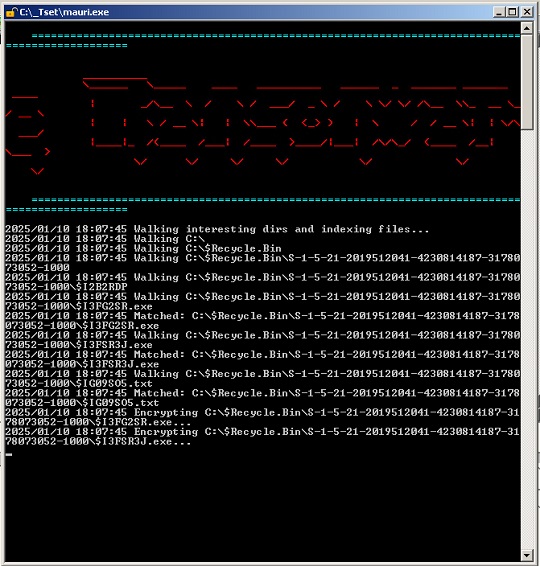Ransom.Win32.RANUIMA.THLACBD
Windows


Threat Type: Ransomware
Destructiveness: No
Encrypted: No
In the wild: Yes
OVERVIEW
Downloaded from the Internet, Dropped by other malware
This Ransomware arrives on a system as a file dropped by other malware or as a file downloaded unknowingly by users when visiting malicious sites.
It connects to a website to send and receive information.
It encrypts files with specific file extensions. It drops files as ransom note.
TECHNICAL DETAILS
5,115,392 bytes
EXE
No
13 Dec 2024
Connects to URLs/IPs, Drops files, Encrypts files
Arrival Details
This Ransomware arrives on a system as a file dropped by other malware or as a file downloaded unknowingly by users when visiting malicious sites.
Installation
This Ransomware drops the following files:
- %User Temp%\{Original File Name} → encrypted copy of target files
- %Desktop%\FILES_ENCRYPTED.html → list of its encrypted files
(Note: %User Temp% is the current user's Temp folder, which is usually C:\Documents and Settings\{user name}\Local Settings\Temp on Windows 2000(32-bit), XP, and Server 2003(32-bit), or C:\Users\{user name}\AppData\Local\Temp on Windows Vista, 7, 8, 8.1, 2008(64-bit), 2012(64-bit) and 10(64-bit).. %Desktop% is the current user's desktop, which is usually C:\Documents and Settings\{User Name}\Desktop on Windows 2000(32-bit), XP, and Server 2003(32-bit), or C:\Users\{user name}\Desktop on Windows Vista, 7, 8, 8.1, 2008(64-bit), 2012(64-bit) and 10(64-bit).)
Backdoor Routine
This Ransomware connects to the following websites to send and receive information:
- http://{BLOCKED}ost:8080
Other Details
This Ransomware does the following:
- It requires a valid response from its C&C server to execute properly.
- It sends its generated victim ID and encryption key to its C&C server.
- It does not encrypt files with sizes greater than 20MB.
- It loads the content of its target file in memory, encrypts it, and drops it as %User Temp%\{Original File Name}. Then it copies its content to the original file and renames it to {Base64 Encoded Original File Name}.locked.
- It displays its logs on a console:

Ransomware Routine
This Ransomware encrypts files with the following extensions:
- .3dm
- .3ds
- .3g2
- .3gp
- .7z
- .accdb
- .ai
- .aif
- .asp
- .avi
- .bak
- .bat
- .bkp
- .blend
- .bmp
- .bump
- .c
- .cc
- .cfg
- .class
- .cmd
- .conf
- .config
- .cpp
- .cs
- .csv
- .dat
- .db
- .DBF
- .dbf
- .dem
- .der
- .dll
- .doc
- .docx
- .eps
- .epub
- .exe
- .flv
- .gam
- .gif
- .go
- .gz
- .h
- .html
- .ico
- .iif
- .indd
- .ini
- .ips
- .jar
- .java
- .jpeg
- .jpg
- .js
- .json
- .jsp
- .key
- .ldb
- .lic
- .lua
- .m3u
- .m4a
- .m4u
- .m4v
- .max
- .mdb
- .mid
- .mkv
- .mov
- .mp3
- .mp4
- .mpa
- .mpg
- .msg
- .nes
- .obj
- .odt
- .pas
- .pct
- .pdb
- .php
- .png
- .pps
- .ppt
- .pptx
- .prf
- .ps
- .ps1
- .psd
- .py
- .rar
- .rb
- .rom
- .sav
- .sdb
- .sh
- .sldm
- .sldx
- .sln
- .sql
- .sqlite
- .sti
- .suo
- .svg
- .sxi
- .tar
- .tgz
- .tif
- .tmp
- .txt
- .vbs
- .vob
- .wav
- .wma
- .wmv
- .wpd
- .wps
- .xlr
- .xls
- .xlsx
- .xml
- .zip
It avoids encrypting files with the following strings in their file path:
- Documents
- Pictures
- Videos
- Music
- Favorites
- Windows
- bootmgr
- $WINDOWS.~BT
- Windows.old
- Temp
- tmp
- Program Files
- Program Files (x86)
It renames encrypted files using the following names:
- {Base64 Encoded Original File Name}.locked
It drops the following file(s) as ransom note:
- %Desktop%\READ_TO_DECRYPT.html

SOLUTION
9.800
19.774.02
13 Dec 2024
19.775.00
14 Dec 2024
Step 1
Trend Micro Predictive Machine Learning detects and blocks malware at the first sign of its existence, before it executes on your system. When enabled, your Trend Micro product detects this malware under the following machine learning name:
- Troj.Win32.TRX.XXPE50FFF088
Step 2
Before doing any scans, Windows 7, Windows 8, Windows 8.1, and Windows 10 users must disable System Restore to allow full scanning of their computers.
Step 3
Note that not all files, folders, and registry keys and entries are installed on your computer during this malware's/spyware's/grayware's execution. This may be due to incomplete installation or other operating system conditions. If you do not find the same files/folders/registry information, please proceed to the next step.
Step 4
Search and delete these files
- %Desktop%\FILES_ENCRYPTED.html
- %Desktop%\READ_TO_DECRYPT.html
- %User Temp%\{Original File Name}
Step 5
Scan your computer with your Trend Micro product to delete files detected as Ransom.Win32.RANUIMA.THLACBD. If the detected files have already been cleaned, deleted, or quarantined by your Trend Micro product, no further step is required. You may opt to simply delete the quarantined files. Please check the following Trend Micro Support pages for more information:
Step 6
Restore encrypted files from backup.
Did this description help? Tell us how we did.

